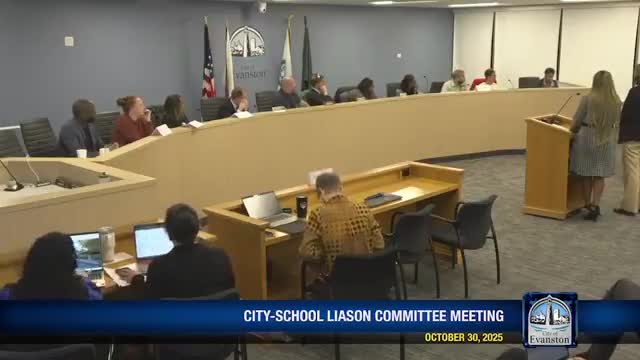City presents draft Strategic Housing Plan; officials and school leaders discuss asset-sharing and repurposing options
October 31, 2025 | Evanston, Cook County, Illinois
This article was created by AI summarizing key points discussed. AI makes mistakes, so for full details and context, please refer to the video of the full meeting. Please report any errors so we can fix them. Report an error »

City staff presented a draft Strategic Housing Plan and a housing-gap analysis at the City School Liaison Committee's Oct. 30 meeting and discussed possible collaboration with District 65 on property use and anti-displacement measures.
Sarah Flax, Community Development Director, said Evanston saw modest population growth in the 2020 census but faces a significant housing mismatch: high housing-cost burden (48% of renters and about 24% of owners), decreasing household size and concentrated cost burden on Black households and renters. She said the city's housing-gap analysis shows an acute shortage of family-sized units for moderate-income households.
The draft strategic plan sets three primary objectives: preserve existing affordable housing, create new housing to address supply gaps, and protect residents from displacement. Proposed tools include preserving naturally occurring affordable housing, community land trusts and limited-equity cooperatives, targeted rehab and anti-deconversion measures, and leveraging city-owned sites for redevelopment. The draft also flags the need to diversify funding and to develop measurable goals for long-term affordability.
Mayor Biss and City Manager Luke Stowe told the committee the city is willing to explore asset-sharing with District 65. "I've asked [city] staff to stand ready to partner with District 65 on this, to whatever extent you guys are open to that conversation," Mayor Biss said, and encouraged staff-level conversations about how city-owned and school-owned properties might be used to reduce capital pressure and preserve services.
Timing and constraints: City staff said many housing interventions take years to reach scale and that federal funding uncertainty complicates near-term financing. City economic-development staff said the highest near-term focus is evaluating three city properties (police/fire facilities, Noyes Cultural Arts Center, and 2100 Ridge) and seeking input on potential reuse.
Next steps: Council members and District 65 board members suggested creating a joint working group, including staff and elected members, to explore potential partnerships, shared use of facilities, and community engagement processes. City staff committed to providing lists of city assets and coordinating outreach for a working group.
Ending: City and district leaders agreed to pursue a more formal, near-term working group to evaluate repurposing and partnership opportunities and to include community engagement in any planning process.
Sarah Flax, Community Development Director, said Evanston saw modest population growth in the 2020 census but faces a significant housing mismatch: high housing-cost burden (48% of renters and about 24% of owners), decreasing household size and concentrated cost burden on Black households and renters. She said the city's housing-gap analysis shows an acute shortage of family-sized units for moderate-income households.
The draft strategic plan sets three primary objectives: preserve existing affordable housing, create new housing to address supply gaps, and protect residents from displacement. Proposed tools include preserving naturally occurring affordable housing, community land trusts and limited-equity cooperatives, targeted rehab and anti-deconversion measures, and leveraging city-owned sites for redevelopment. The draft also flags the need to diversify funding and to develop measurable goals for long-term affordability.
Mayor Biss and City Manager Luke Stowe told the committee the city is willing to explore asset-sharing with District 65. "I've asked [city] staff to stand ready to partner with District 65 on this, to whatever extent you guys are open to that conversation," Mayor Biss said, and encouraged staff-level conversations about how city-owned and school-owned properties might be used to reduce capital pressure and preserve services.
Timing and constraints: City staff said many housing interventions take years to reach scale and that federal funding uncertainty complicates near-term financing. City economic-development staff said the highest near-term focus is evaluating three city properties (police/fire facilities, Noyes Cultural Arts Center, and 2100 Ridge) and seeking input on potential reuse.
Next steps: Council members and District 65 board members suggested creating a joint working group, including staff and elected members, to explore potential partnerships, shared use of facilities, and community engagement processes. City staff committed to providing lists of city assets and coordinating outreach for a working group.
Ending: City and district leaders agreed to pursue a more formal, near-term working group to evaluate repurposing and partnership opportunities and to include community engagement in any planning process.
Don't Miss a Word: See the Full Meeting!
Go beyond summaries. Unlock every video, transcript, and key insight with a Founder Membership.
✓
Get instant access to full meeting videos
✓
Search and clip any phrase from complete transcripts
✓
Receive AI-powered summaries & custom alerts
✓
Enjoy lifetime, unrestricted access to government data
30-day money-back guarantee

